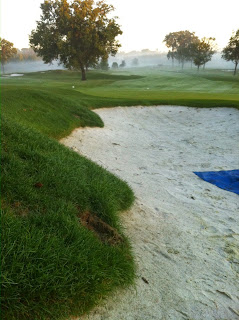 |
| This is the right greenside bunker on the 2nd hole, you can see some turf damage at the bottom 1\3 of the picture. |
Friday, September 26, 2014
Bunker damage from "Hill climbers".
Thursday, September 25, 2014
New cart path's and a new tee at WVCC.
 |
| Senior Asst. supt. Jerry Stockmal leveling the mix for the new tee on the 18th hole. The majority of this tee came from the soil generated from the new cart path. |
 |
| Santos Lopez making sure the grade next to the path at #10 is proper. |
 |
| A final rolling by asst. supt. Jim Dennison to make sure the tee is tabletop smooth. |
 |
| A different method for ensuring a level tee. Dave Joyce and Jerry Stockmal using an ladder section to knock down any high points on the tee. |
Monday, September 22, 2014
Paving Day!
Friday, September 12, 2014
Cart path work being done on holes 3, 10 and 18.
 |
| On the 18th hole 250 linear feet of path was added from the tee to the left side of the fairway. The soil that was removed was used to create an additional tee on the hole. |
 |
| This is a view of the 3rd hole looking at the green. The path next to the green end of the fairway was pulled away 12 feet. An additional path was added to connect the path at #3 to the path at#14. |
Friday, September 5, 2014
Fairway aeration process.
 |
| John Fleming shown aerating the 10th fairway at WVCC. |
 |
| Jerry Stockmal is supplementing the process by using a walk behind unit to aerate the approach and fairway edges. |
 |
| As organic matter and soil that is too hard to break up accumulates, we use snow shovels to congregate the material into piles. |
 |
| A smaller more maneuverable blower aides in this process by creating condensed piles for pick up. |
 |
| Piles getting condensed even tighter. |
Subscribe to:
Posts (Atom)






